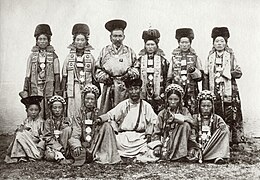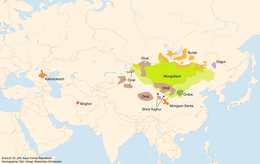Buryats
The Buryats , also outdated Buryat and Buryat Mongols ( Buryat Буряадууд ), are a Mongolian ethnic group in Siberia , especially in Buryatia , and in the areas of Chita and Irkutsk . Smaller groups live in Mongolia and the People's Republic of China . In 1989 there were 423,436 Buryats in the Soviet Union, making them the largest national minority in Siberia. In addition to Buryat , they mainly speak Russian today.
history
The name "Buryats" is mentioned for the first time in the Secret History of the Mongols (probably in 1240). The Russian state annexed the population and the territory by treaties of 1668 and 1728, which separated the areas on both sides of Lake Baikal from Mongolia. The Buryat population grew from 27,700 in the middle of the 17th century to 300,000 in the early 20th century.
The historical roots of the Buryat culture are related to those of the Mongols. After Buryatia was annexed to Russia, it was exposed to two traditions: Christianity and Buddhism . The Buryats west of Lake Baikal (western Buryats) were " Russified " and soon gave up the nomadic pastoral way of life in favor of agriculture, whereas the Buryats living to the east (Transbaikal) are closer to the Mongols. They lived the nomadic way of life longer than the western Buryats and now no longer live in yurts , but are mostly Buddhists. In 1741, the Lamaist branch of Buddhism was officially recognized as a religion in Russia, and the first Buryat Dazan (Buddhist monastery ) was built.
The second half of the 19th century and the beginning of the 20th century were a period of growth for the Buryat Buddhist religion (48 Dazans 1914). Buddhism became an important factor in the cultural development of the Buryats. After the October Revolution , most lamas were loyal to the Soviet state. In 1925 a fight against religion and church began in Buryatia. The driving force here was Andrej Smetankin. Gradually Dazans were closed and the activities of the church restricted. As a result, the Buddhist denomination largely ceased to exist in 1930 and thousands of cultural treasures were destroyed. Efforts to revive the organization of Buddhism began during World War II, after which it was re-established in 1946. A real resurgence of Buddhism took place in the late 1980s, which proved to be an important factor in national unity and spiritual rebirth.
In 1923 the Buryat-Mongol Autonomous Soviet Socialist Republic was established; it included the Baikal Province (Pribaykalskaya guberniya) with a majority Russian population. In 1937 the government of Stalin, with the intention of dividing the Buryats into different administrative units, separated some areas ( Rajons ) from the Buryat-Mongolian ASSR and formed the two autonomous Buryat districts ( Okrug ) Ust-Orda and Aga . At the same time, some districts with a Buryat population were completely split off. Fearing Buryat nationalism , Joseph Stalin murdered more than 10,000 Buryats. In 1958 the name “Mongolian” was removed from the name of the republic (Buryat ASSR). In 1990 the BASSR declared itself independent and in 1992 adopted the name Republic of Buryatia . The constitution of the republic was adopted by parliament in 1994, and in 1995 a bilateral agreement was signed with the Russian Federation .
religion

The original religion of the Buryats was Tengrism . Towards the end of the 19th century, however, Buddhism was also established among the Trans-Baikal Buryats and influenced everyday life, culture and view of life. This led to a syncretistic mixing of the previously animistic-shamanic with Buddhist ideas. An example is the shaman mirror toli, originally from China, among the Buryats and the appearance of people who were both lama and shamans .
The former shaman of the Buryats included the crown of antlers, a shaman's stick and the toli mirror. He had a wide range of duties - among other things as a soul companion and fortune teller - and a high status. There were male and female shamans. As with many Mongolian and Turkic peoples, there was an eagle cult and also a sun cult as in the old Iranian religion.
Despite the Russification and Sovietization in the 20th century, which brought massive changes in the previous way of life and culture, shamanism survived. However, today's shamans no longer serve the welfare of individual clans, but have founded organizations in which one can use their services as healers or ritual companions and which are dedicated to the preservation or reconstruction and transmission of traditional knowledge . The shamans have become a symbol of the cultural identity of all Buryats, although many aspects of shamanism have already been lost. In order to compensate for this, contacts were established with western esoteric neo-shamanism , which, however, leads to considerable distortions of ethnic ideas.
Famous Buryats
- Bair Badjonow - archer
- Yul Brynner - American actor (grandmother was Buryat)
- Agwan Dorjieff - Buddhist monk, diplomatic representative of the 13th Dalai Lama
- Valéry Inkijinoff - actor
- Jurij Jechanurow - Ukrainian politician
- Vladimir Yeschejew - archer
- Irina Pantajewa - photo model and actress
Individual evidence
- ↑ James Forsyth: A History of the Peoples of Siberia. Russia's north Asian colony; 1581-1990 . New edition University Press, Cambridge 2010, ISBN 978-0-521-47771-0
- ↑ Erich Kasten (ed.): Shamans of Siberia. Mage - Mediator - Healer. On the exhibition in the Linden Museum Stuttgart, December 13, 2008 to June 28, 2009, Reimer Verlag 2009, ISBN 978-3-496-02812-3 , pp. 164–167.
- ↑ Gabriel Gutiu: The change of shamanism in Buryatia - An explanation taking into account the investigation of Winkelman and cultural materialist theory. Diploma thesis, University of Vienna 2012. Online version : pp. 68–69, 85–86, 89, 91–92.
- ^ Ippei Shimamura, The Roots Seekers: Shamanism and Ethnicity Among the Mongol Buryats. Yokohama, Japan: Shumpusha, 2014; ISBN 978-4-86110-397-1
Web links
- The Buryats. Radio Voice of Russia, September 18, 2010, accessed November 17, 2013 .
- Catrin Watermann: With Genghis Khan and Khodorkovsky. Berliner Zeitung, March 28, 2008, archived from the original on April 1, 2008 ; Retrieved November 17, 2013 .


